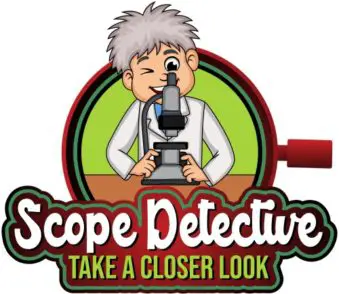 About this Article: I researched 9 microscopes before buying this one. If you want to see all the microscopes I researched, see my article on the 9 best compound microscopes. This information was for my personal circumstances only and is not professional advice to you. Read more on the website’s disclaimer page. All images on this page are my own. As an Amazon associate I earn from qualifying purchases.
About this Article: I researched 9 microscopes before buying this one. If you want to see all the microscopes I researched, see my article on the 9 best compound microscopes. This information was for my personal circumstances only and is not professional advice to you. Read more on the website’s disclaimer page. All images on this page are my own. As an Amazon associate I earn from qualifying purchases.The Levenhuk Rainbow 50L PLUS is a microscope designed and marketed for children and teenagers but provides sufficient quality magnification for viewing bacteria and other opaque specimen.
I bought this microscope because it was in my opinion the best for kids. Here’s a photo of my one straight out of the box:
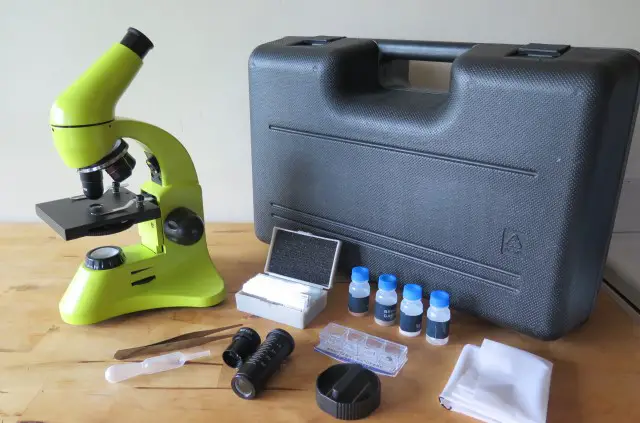
The “rainbow” in the title refers to the range of different colors you can choose – so you can get a microscope in your child’s favorite color! I chose lime green.
The specifications of this microscope are good for a beginner scope and provide room for intellectual growth through intermediate and advanced level experiments. It has 64x–1280x magnification (400x is all you need for high school biology!) and both above and under-stage lighting for viewing a range of visible and opaque specimen. This magnification is good enough right through high school biology.
The monocular head with Barlow lens further improves user experience for children. A Barlow lens will generally make it easier to look through an eyepiece because you can look through the lens from a bit more distance. This also makes it good for people with glasses.
The two downsides of this model are that there isn’t a mechanical stage (to be fair, no microscope at this price point has a mechanical stage that I know of) and there isn’t a fine focus adjustment knob.
You can get by with coarse focus, but some comparable models at this price point do come with fine focus knobs. I would guess that they went without the fine focus knob to avoid overcomplicating the setup for children.

My Overall Verdict: This is a good microscope for children and teenagers. I like it because:
- It has the magnification required for children to see a wide range of specimens including bacteria and fish eggs
- It’s designed to provide a child friendly user experience, and it comes in at a decent price point.
So, I bought this microscope. You can also but the Levenhuk Rainbow 50L PLUS here.
Levenhuk Rainbow 50L PLUS Review
When reviewing microscopes, I usually start at the head and move down. That’s how it’ll work here, too – so let’s start at the head!
1. Monocular Head
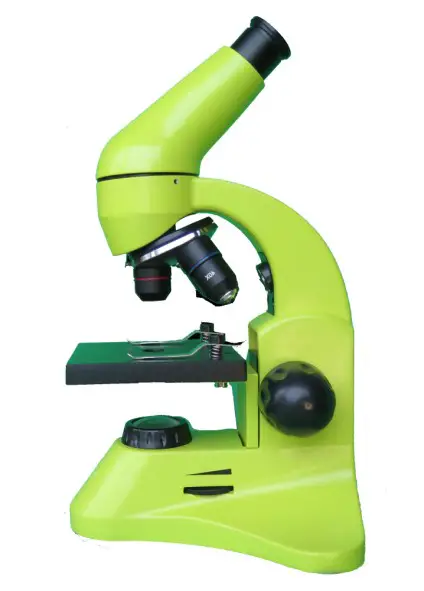 Image: Personal Image
Image: Personal Image
A lot of people balk at a monocular head and think a binocular head is somehow superior. It’s not. Or at least, not for kids.
Binocular heads are just another thing to worry about when sharing a microscope with kids. They always want to fiddle and change them so they’re comfortable. Children will also often feel like they can’t see thorough binocular heads. So I always recommend a monocular head for children or even an adult who is sharing a microscope.
The head also rotates 360 degrees. This, again, is good for when you’re sharing a microscope. Overall, I don’t think a rotatable head is a deal breaker or deal maker for me – so this is much of a muchness.
2. Barlow Eyepiece
Most compound microscopes come with two eyepieces – usually a 10x and 25x. This model has gone for one 16x eyepiece with a Barlow lens. The Barlow lens allows you to 2x this magnification, so you’re effectively getting a 16x and 32x eyepiece on this model.
There are some advantages to Barlow lenses. Children tend to be able to use them better, and so do people with eyeglasses, because they’re easier to look through. The one downside is that you don’t get the lower-end 40x magnification that most other competing models offer, which can be good sometimes for examining rocks.
3. Objective Lenses and Total Magnification
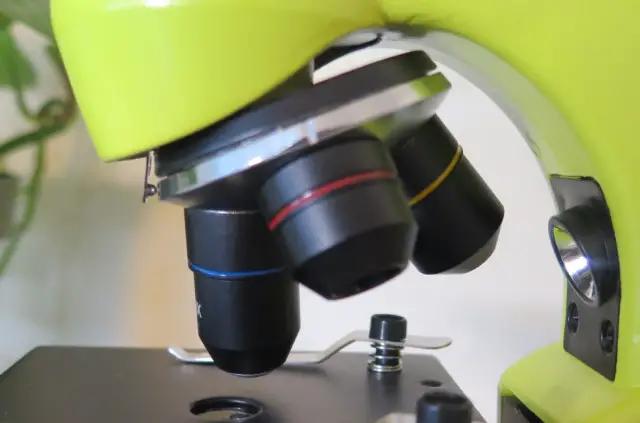
There are 3 objective lenses on the Rainbow 50L PLUS. These are: 4х, 10х and 40x. The 40x is also spring loaded (which helps protect it if you accidentally tap the lens against your slides.
Overall the 1240x total magnification is a little stronger than most competitors in this price point. At that magnification, you’ll be able to see bacteria very clearly, and chances are you’ll be spending 80% of the time working at a much lower magnification level for a better image.
4. Stage and Focus Knobs
The stage can be adjusted vertically but not along the X and Y axis. This means you’ll have to move the slides manually if you misplaced them the first time (i.e. you can’t ‘scan’ your field of view). This isn’t a bad thing necessarily – you don’t tend to get mechanical stages until you’re up into the next price point. Check out the Levenhuk D740T for example.
You can move the stage up and down using the coarse focus knob on the microscope. There’s no fine focus knob which personally I’d much prefer to see, but I understand it might be a easier for young children to have just the one knob to work with and adjust.
One thing I did notice was that the coarse focus knob is a bit stiff, so children might need a hand working with it until they get their minds around it.
Overall, the stage and focus knobs are my least favorite features on this model, but not deal breakers, and the quality of these features are to be expected at this price point.
5. Lights and Power Source
This model has both overhead lights and lights below the stage. The overhead lights are best for visible specimens like rocks, feathers and coins while the below stage illuminator is best for opaque specimen such as bacteria. There’s a stage diaphragm for adjusting the amount of light that goes through the lens.
The microscope can be powered by AA batteries or being plugged into a wall.
Overall, these features are all to be expected for a microscope at this price point. So this is a pass / fail metric and here the Rainbow 50L gets a pass in my books.
6. Included Experiment Kit
The experiment kit that is included was really fun to work through. Here’s the kit:
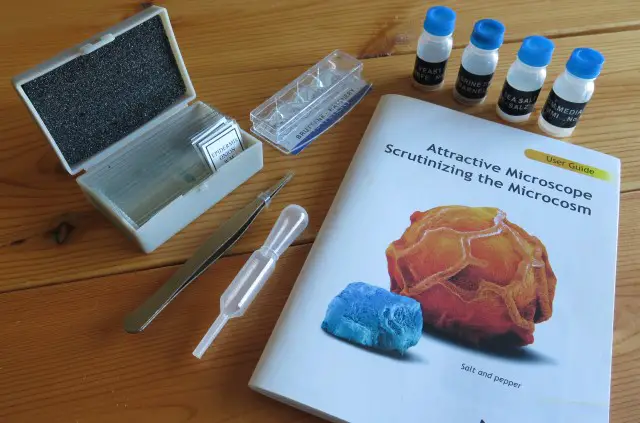
One thing I really appreciate about included experiment kits is you have something to look at immediately. Within about 5 minutes of getting the microscope out of the box, I was looking at this fly leg which was included on a prepared slide in the experiment kit:

You’ll be able to blast through the 5 prepared slides, then do another few experiments where you can prepare your own slides (blank slides included).
Overall, the included experiment kit was fun and really good value.
7. Photography
There is no camera included in this model, although there is a version (The D50L PLUS) which does have an in-built 2MP camera.
Personally, I think if you’re keen on photomicroscopy this isn’t the microscope for you. It’s better to get a trinocular head microscope and a DSLR to microscope adapter, like I did with my Amscope T490B coupled with the CA-CAN-NIK-SLR adapter.
But for those who just want to take simple photos and don’t care about the images being the best quality, you can simply hold up a cell phone camera to the eyepiece of your Levenhuk Rainbow 50L PLUS, like I am demonstrating here:
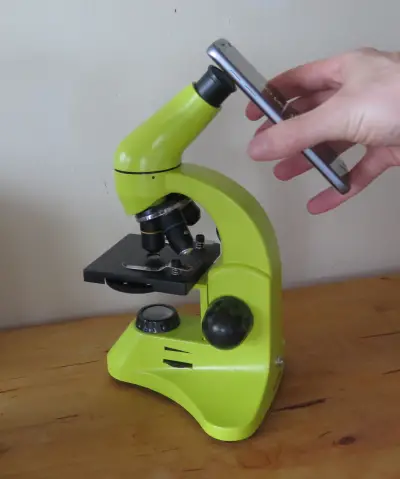
(The photo of the fly leg earlier in this article was taken using this method, to give you an idea of the quality you can get with a cell phone camera + microscope setup).
> See more: 3 Methods for Taking Photos with a Microscope
Downsides
The Levenhuk 50L PLUS has all the required features for getting started. But there are a few things I do wish it included:
- No USB Digital Camera – Levenhuk offers a version of the 50L PLUS with a 2MP digital USB camera (which I love). This camera offers full HD images and video, and the digital version is quite affordable for a digital microscope.
- No Mechanical Stage – A mechanical stage allows you to move your slides around as you’re looking through the lends. No microscope at this price point comes with a mechanical stage. You can step up to a more expensive model with a mechanical stage, though.
- No Fine Focus – I’d prefer if it came with both coarse and fine focus knobs. However, the simplicity of just one knob might be good for kids.
My Final Verdict
Overall, I’m a big fan of the Levenhuk 50L PLUS for an affordable child-friendly microscope that will grow with children’s intellectual curiosity. You could do intermediate and some advanced experiments with this microscope, too.
The one thing I think is worth considering is stepping up to the D50L PLUS to get a digital camera included in your purchase. They’re great for presentations of printing images for posters for students.
And for adults who want to do more advanced experiments, I’d recommend stepping up to the Levenhuk D740T which is a digital trinocular microscope, or the one I own: the Amscope T490B.
Hi, I’m Chris and I run things around here! I share all my microscopy experiments, microscope information and tricks, how to guides, and microscope reviews in the articles on this site. Browse around to see what you like (I recommend the experiment ideas section) or connect with me on any of the social platforms listed below.
